For Yogi Bear, Rhythm & Hues mixed 3D versions of the beloved Hanna-Barbera characters with live action whilst preserving the popular elements of the 2D cartoons. We talk to visual effects supervisor Betsy Paterson and animation director Joe Ksander about getting the right performances out of a 3D Yogi and Boo Boo.
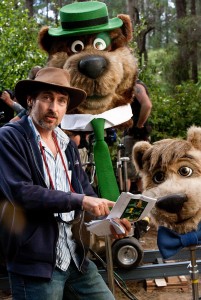
Directed by Eric Brevig, this hybrid live action/CG and stereo incarnation of the original cartoons is voiced by Dan Aykroyd (Yogi) and Justin Timberlake (Boo Boo). The characters continue their adventures in Jellystone Park which must be saved from certain closure. Rhythm & Hues was a production partner on the film and began doing early tests in April 2009. The studio then spent a further six months developing the characters and a stereo pipeline for production.
Principal photography began in October 2009 and finished in March 2010. The film was shot like a typical production requiring visual effects, although Rhythm was of course involved throughout the whole process. “We did quite a bit of previs before shooting started to get a sense of how the scenes were going to play out,” says visual effects supervisor Betsy Paterson. “Then we had stand-ins on set and we would shoot one or two takes with the stand-ins so that the actors could see what the characters were going to be doing. Then we would shoot a clean version as the hero shot.”
The stand-ins were the same heights as Yogi and Boo Boo, and wore the right character colours, sometimes with a fur vest and brown coloured pants so that DOP Peter James could light them correctly. “They weren’t doing the full performance and were not acting the full roles,” says Rhythm & Hues animation director Joe Ksander. “Mostly this was for time purposes and eyelines where they didn’t want to spend time on that as the performance would be changed. I sometimes delivered the lines off screen to help people know what would be happening.” The usual HDRs, chrome balls, eyeline sticks and stuffy heads of Yogi and Boo Boo were also utilised on the set for reference.
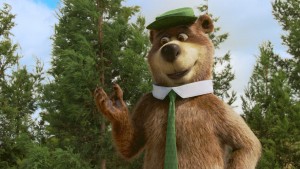
A major consideration in creating a modern live action/animated Yogi Bear film was re-designing the original characters for the 3D world. “There’s a big jump from the graphic TV style of the 50s and 60s to having characters interact with live actors on screen,” notes Ksander. “We wanted to make that transition but we didn’t want to give up the things that made those characters appealing in the 2D world.”
Artists at Rhythm studied Yogi characterisations of the previous 40 years. Surprisingly, these varied greatly, from the black and white TV show versions to theatrical productions and consumer product designs. “We actually went back to the basic principles,” says Ksander. “When the characters were originally designed it was purely for TV on a TV budget. They were actually designed to be limited in terms of their animation. Then to make a drawing that doesn’t move a lot on screen, it has to have a really strong fundamentally balanced and appealing design.”
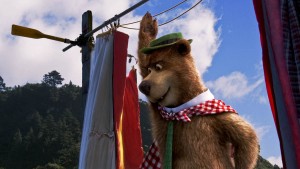 “Because they didn’t have a lot of money for the TV show,” continues Ksander, “there were a lot of re-used walk cycles with a different head delivering the dialogue. We could animate him more for the film, of course, but that kind of thing fed into Yogi’s personality – this is a character who doesn’t move if he doesn’t have to. From an acting stand-point, that’s actually a symbol of someone who’s confident and self-assured. They let people come to them. So Yogi will strike a pose to deliver his dialogue and only break it when his self-image gets shattered.”
“Because they didn’t have a lot of money for the TV show,” continues Ksander, “there were a lot of re-used walk cycles with a different head delivering the dialogue. We could animate him more for the film, of course, but that kind of thing fed into Yogi’s personality – this is a character who doesn’t move if he doesn’t have to. From an acting stand-point, that’s actually a symbol of someone who’s confident and self-assured. They let people come to them. So Yogi will strike a pose to deliver his dialogue and only break it when his self-image gets shattered.”
Rhythm used those limitations to help define the characters. “Even though in CG we have fully 3D characters with full camera moves, we wanted to preserve the balance and composition and asymmetry from the original characters,” says Ksander. “Using that design language, and adapting that now that Yogi and Boo Boo have full colour and fur, they still have a clean silhouette, clean lines and strong shapes.”
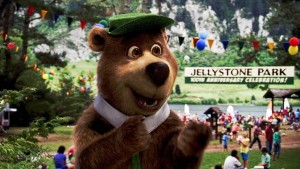 Starting with 2D artwork, artists at Rhythm roughed out models of Yogi and Boo Boo in Zbrush and created some small maquette sculpts to define the form and show facial expressions. In Photoshop, the early digital models were painted over with realistic fur, eyes and reflections to further refine the look. Finally, Rhythm’s proprietary Voodoo software was used for final modelling.
Starting with 2D artwork, artists at Rhythm roughed out models of Yogi and Boo Boo in Zbrush and created some small maquette sculpts to define the form and show facial expressions. In Photoshop, the early digital models were painted over with realistic fur, eyes and reflections to further refine the look. Finally, Rhythm’s proprietary Voodoo software was used for final modelling.
“When you’re modelling Yogi, say, you actually have this naked bear skin with no fur on it,” says Ksander. “It’s like this giant fat bear who has been totally de-furred. You also have to work out how much muscle to add in, knowing that the fur will mute some of it away. It’s almost like trying to draw with oven mitts on! You’re trying to art direct the underlying model – the skinny bear we call him – and then the look dev guys comb and fine-tune the fur. Then you approve both of those steps, put them together in rendering and see what it looks like. Or you’ll pose the character in some personality pose and render it and make changes.”
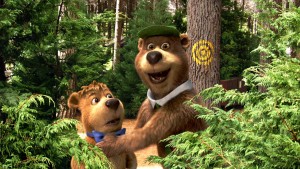 Rhythm relied on typical muscle, fur and fat simulations, but preserved the classic Hanna-Barbera design shapes. “Rigging-wise, we didn’t just leave it at what the muscle sim wanted to do,” says Ksander. “We gave the animators control of the silhoutette and the body shape curves as graphic design, art-directable shapes. This was a little bit more than they would normally have to do on a film like this. Usually they would just let the cloth or fur sim do the final work for them. This time we put a little more burden on the animators themselves to control the silhouette to ensure the characters stayed appealing even in the most unusual circumstances.”
Rhythm relied on typical muscle, fur and fat simulations, but preserved the classic Hanna-Barbera design shapes. “Rigging-wise, we didn’t just leave it at what the muscle sim wanted to do,” says Ksander. “We gave the animators control of the silhoutette and the body shape curves as graphic design, art-directable shapes. This was a little bit more than they would normally have to do on a film like this. Usually they would just let the cloth or fur sim do the final work for them. This time we put a little more burden on the animators themselves to control the silhouette to ensure the characters stayed appealing even in the most unusual circumstances.”

Once principal photography was completed, editorial delivered a pre-cut made from the best on-set performances. All of the scenes featuring Yogi and Boo Boo were then storyboarded with 2D drawings comped into the live action to further allow for editing. “That let us really flesh out the performance of the bears,” says Ksander. “It’s much more entertaining to see a bear acting, even if it’s in a rough drawing, than it is to see a stuffie or a stand-in. We actually ended up doing test screenings with some of these storyboarded bears in there.”
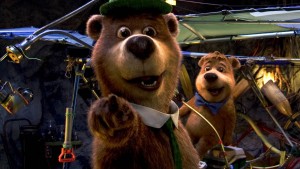 Storyboarding segued into CG animation, again using Rhythm’s Voodoo toolset. Although animators did look to video reference of the voice performances of Aykroyd and Timberlake, the physical design of the bears was so different that they had a fair amount of freedom to invent and decide what the character should be doing. Overall, animators pushed for the funniest delivery possible, especially for the large Yogi. “He’s such a big character that you didn’t want to have him stand next to a human character and for a kid to be scared that he was going to bite the guy’s head off,” says Paterson. “Finding a way for a six-foot bear to smile appealing took a lot of research.”
Storyboarding segued into CG animation, again using Rhythm’s Voodoo toolset. Although animators did look to video reference of the voice performances of Aykroyd and Timberlake, the physical design of the bears was so different that they had a fair amount of freedom to invent and decide what the character should be doing. Overall, animators pushed for the funniest delivery possible, especially for the large Yogi. “He’s such a big character that you didn’t want to have him stand next to a human character and for a kid to be scared that he was going to bite the guy’s head off,” says Paterson. “Finding a way for a six-foot bear to smile appealing took a lot of research.”
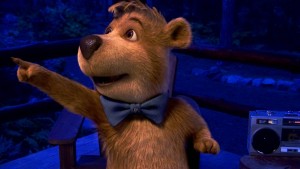 “One of the lessons we learnt was that Yogi had a really flexible and appealing face,” adds Ksander, “but you look at a real bear and in real life it’s actually way more crazy than you ever imagined. So we would look at funny real expressions that bears make. Getting the humour and the dryness and quirky individualism to Yogi was a challenge. We looked at a lot of inspiration like Jackie Gleason – a big guy who moves fast. We also looked to W.C. Fields, a lot of Buster Keaton and even Zach Galifianakis. He’s a very funny big guy with goofy facial expressions and a dry look to camera.”
“One of the lessons we learnt was that Yogi had a really flexible and appealing face,” adds Ksander, “but you look at a real bear and in real life it’s actually way more crazy than you ever imagined. So we would look at funny real expressions that bears make. Getting the humour and the dryness and quirky individualism to Yogi was a challenge. We looked at a lot of inspiration like Jackie Gleason – a big guy who moves fast. We also looked to W.C. Fields, a lot of Buster Keaton and even Zach Galifianakis. He’s a very funny big guy with goofy facial expressions and a dry look to camera.”
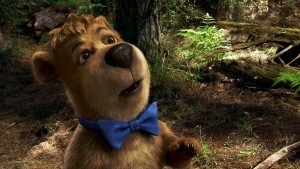
Once animated, the bear characters went through a series of technical processes, including the addition of CG fur. Groomers combed guide hairs and a separate team of tech animators dealt with the fur’s secondary motion when it blows in the wind or simply bounces up and down. Clothing, such as ties and hats, was also subject to physical simulations on top of the underlying character animation.
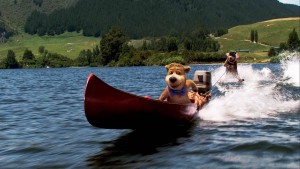
In one particularly complicated sequence when Yogi goes waterskiing, the animation and fur needed to work in dramatic, windy and wet conditions. Production shot the sequence with a practical motored canoe that pulled a champion New Zealand waterskier. “We shot a pass of him doing straight skiing,” says Paterson, “and then doing it again on one foot, and then we shot the same thing again with nobody there as a blank plate.”
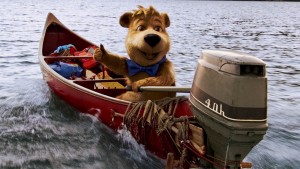
Rhythm painted out the real waterskier and added dry/wet iterations of the CG Yogi, using the clean plate for patch-ups, or totally reconstructing the scene when the bear needed to perform extreme moves. Yogi’s fur also had to look wet, which basically called for more clumping and detail. “We did a whole set of new texture maps and lighting so that the fur look darker and more reflective and shinier,” says Paterson. “Then we had a way to mix between the two, between the dry fur and the wet fur, so that he could get progressively more wet to the point where he is just dripping and there are drops coming off.”
Artists occasionally blended in CG water created in Houdini with the live action, as well as photorealistic foam and real water elements. “We just did whatever was necessary for the shot,” notes Ksander. “Sometimes that meant we could drop a weight in the water to get a splash, or there’s another shot of Yogi skimming across the water like a stone that couldn’t be replicated in live action so the water interaction had to be totally simulated.”
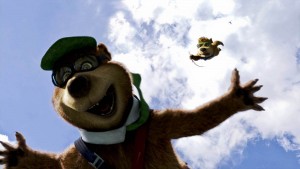
Ultimately, Rhythm delivered 550 shots for Yogi Bear, with the force of about 350 artists working on the film in the studio’s Los Angeles, India and Malaysia offices. “One thing I discovered,” says Ksander, “was that it’s hard to get 300 people to tell the same joke. As animation director, I spent a lot of time pitching a joke and performing the joke to people. There’s one scene where Yogi is laying in his cave and doing nothing but eating ice-cream and moaning, like a boyfriend who has been broken up with. That’s a really simple joke, but it’s a hard thing to convey. There’s rain, fur and CG food and ice-cream on his mouth and you’ve got to get everybody doing their amazing technical jobs, but the important thing in the shot was really just his eyes because when he looks up at the rain that’s funny.”
